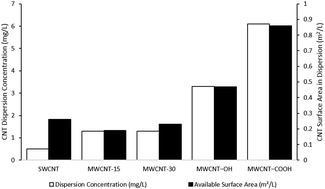当前位置:
X-MOL 学术
›
Environ. Sci.: Nano
›
论文详情
Our official English website, www.x-mol.net, welcomes your feedback! (Note: you will need to create a separate account there.)
Challenges in characterizing the environmental fate and effects of carbon nanotubes and inorganic nanomaterials in aquatic systems
Environmental Science: Nano ( IF 7.3 ) Pub Date : 2017-11-28 00:00:00 , DOI: 10.1039/c7en00594f Peter Laux 1, 2, 3, 4 , Christian Riebeling 1, 2, 3, 4 , Andy M. Booth 5, 6, 7 , Joseph D. Brain 8, 9, 10 , Josephine Brunner 1, 2, 3, 4 , Cristina Cerrillo 11, 12, 13, 14 , Otto Creutzenberg 4, 15, 16, 17 , Irina Estrela-Lopis 4, 18, 19, 20 , Thomas Gebel 4, 21, 22 , Gunnar Johanson 23, 24, 25, 26 , Harald Jungnickel 1, 2, 3, 4 , Heiko Kock 4, 15, 16, 17 , Jutta Tentschert 1, 2, 3, 4 , Ahmed Tlili 27, 28, 29, 30, 31 , Andreas Schäffer 4, 32, 33, 34 , Adriënne J. A. M. Sips 35, 36, 37 , Robert A. Yokel 10, 38, 39, 40 , Andreas Luch 1, 2, 3, 4
Environmental Science: Nano ( IF 7.3 ) Pub Date : 2017-11-28 00:00:00 , DOI: 10.1039/c7en00594f Peter Laux 1, 2, 3, 4 , Christian Riebeling 1, 2, 3, 4 , Andy M. Booth 5, 6, 7 , Joseph D. Brain 8, 9, 10 , Josephine Brunner 1, 2, 3, 4 , Cristina Cerrillo 11, 12, 13, 14 , Otto Creutzenberg 4, 15, 16, 17 , Irina Estrela-Lopis 4, 18, 19, 20 , Thomas Gebel 4, 21, 22 , Gunnar Johanson 23, 24, 25, 26 , Harald Jungnickel 1, 2, 3, 4 , Heiko Kock 4, 15, 16, 17 , Jutta Tentschert 1, 2, 3, 4 , Ahmed Tlili 27, 28, 29, 30, 31 , Andreas Schäffer 4, 32, 33, 34 , Adriënne J. A. M. Sips 35, 36, 37 , Robert A. Yokel 10, 38, 39, 40 , Andreas Luch 1, 2, 3, 4
Affiliation

|
The current lack of commonly used protocols for dispersion, characterization, and aquatic toxicity testing of nanomaterials (NMs) has resulted in inconsistent results, which make meaningful comparisons difficult. The need for standardized sample preparation procedures that allow the reproducible generation of relevant test conditions remains a key challenge for studies of the environmental fate and aquatic toxicity of NMs. Together with the further development of optimized and cost-effective analytical techniques for physicochemical characterization that depend on reproducible sample preparation, such methods have the potential to overcome the current uncertainties with regard to NM dispersion properties, effective dose, and particle dissolution. In this review, recent data available on the challenges are summarized, especially those associated with preparing and quantifying NM dispersions, determining NM uptake and accumulation in aquatic organisms, and the transformation of organic and inorganic NM in aquatic species. Additional limitations and challenges that are specific to certain types of NMs are highlighted. The release of highly persistent carbon nanotubes (CNTs) from nanocomposites is determined to be a potential source of environmental contamination. Furthermore, the role of NM dissolution and the contribution of ions versus particles to NM toxicity are discussed. A phenomenon of particular relevance for the environment is photoactivation of NMs. This is elucidated with regard to its consequences in complex aquatic ecosystems. Widespread implementation of standardized protocols alongside the consideration of phenomena associated with different life cycle stages of industrial products is crucial to the future establishment of NM environmental risk assessment.
中文翻译:

表征水生系统中环境命运以及碳纳米管和无机纳米材料的影响所面临的挑战
当前缺乏用于纳米材料(NMs)的分散,表征和水生毒性测试的常用协议,导致结果不一致,这使有意义的比较变得困难。对于标准化的样品制备程序的需求,需要可重复生成相关的测试条件,这仍然是研究NMs的环境命运和水生毒性的关键挑战。结合可重复制备样品的物理化学表征的优化且经济高效的分析技术的进一步发展,此类方法具有克服目前有关NM分散特性,有效剂量和颗粒溶解性的不确定性的潜力。在这篇评论中,总结了有关挑战的最新数据,尤其是与制备和量化NM分散体,确定NM在水生生物中的吸收和积累以及水生物种中有机和无机NM转化有关的那些。强调了特定于某些类型的NM的其他限制和挑战。从纳米复合材料中释放出高持久性的碳纳米管(CNT)被确定为潜在的环境污染源。此外,NM溶解的作用和离子的贡献 从纳米复合材料中释放出高持久性的碳纳米管(CNT)被确定为潜在的环境污染源。此外,NM溶解的作用和离子的贡献 从纳米复合材料中释放出高持久性的碳纳米管(CNT)被确定为潜在的环境污染源。此外,NM溶解的作用和离子的贡献与颗粒对NM的毒性进行了讨论。与环境特别相关的现象是NMs的光活化。关于其在复杂水生生态系统中的后果,对此进行了阐明。标准化协议的广泛实施以及对与工业产品不同生命周期阶段相关的现象的考虑,对于未来建立NM环境风险评估至关重要。
更新日期:2017-11-28
中文翻译:

表征水生系统中环境命运以及碳纳米管和无机纳米材料的影响所面临的挑战
当前缺乏用于纳米材料(NMs)的分散,表征和水生毒性测试的常用协议,导致结果不一致,这使有意义的比较变得困难。对于标准化的样品制备程序的需求,需要可重复生成相关的测试条件,这仍然是研究NMs的环境命运和水生毒性的关键挑战。结合可重复制备样品的物理化学表征的优化且经济高效的分析技术的进一步发展,此类方法具有克服目前有关NM分散特性,有效剂量和颗粒溶解性的不确定性的潜力。在这篇评论中,总结了有关挑战的最新数据,尤其是与制备和量化NM分散体,确定NM在水生生物中的吸收和积累以及水生物种中有机和无机NM转化有关的那些。强调了特定于某些类型的NM的其他限制和挑战。从纳米复合材料中释放出高持久性的碳纳米管(CNT)被确定为潜在的环境污染源。此外,NM溶解的作用和离子的贡献 从纳米复合材料中释放出高持久性的碳纳米管(CNT)被确定为潜在的环境污染源。此外,NM溶解的作用和离子的贡献 从纳米复合材料中释放出高持久性的碳纳米管(CNT)被确定为潜在的环境污染源。此外,NM溶解的作用和离子的贡献与颗粒对NM的毒性进行了讨论。与环境特别相关的现象是NMs的光活化。关于其在复杂水生生态系统中的后果,对此进行了阐明。标准化协议的广泛实施以及对与工业产品不同生命周期阶段相关的现象的考虑,对于未来建立NM环境风险评估至关重要。



























 京公网安备 11010802027423号
京公网安备 11010802027423号